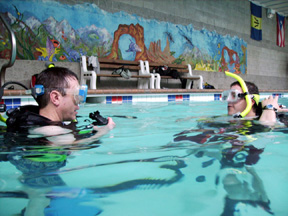Specialty Instructor – What? Why? How?
Divers get into diving to dive, and many have a specific reason for diving. Perhaps it’s underwater photography or exploring wrecks. Instructors are divers, too. When you combine specialized interests with teaching, you’re a motivated instructor. Specialty Instructor ratings are the way to share your specialized interests with your student divers.
To become a PADI Specialty Instructor, you need to do one of three things:
- Attend a Specialty Instructor course offered by a Course Director
- You must be a PADI Open Water Scuba Instructor
- Lowest application fee, but there will probably be a tuition charge
- You don’t need to have certified 25 divers
- You only need to be able to document 10 dives in the specialty area
- Apply directly to PADI to teach a standardized (PADI-authored) Specialty
- You must be a PADI Open Water Scuba Instructor
- You need to have certified 25 divers
- You need to be able to document at least 20 dives in the specialty area
- Higher application fee
- You have to learn how to teach the specialty as you teach it: may be suboptimal for your students.
- Author a specialty outline and apply directly to PADI
- Highest application cost, requires the most documentation and requires a lot of work on your part
So, you’re thinking, I’ll just apply directly and save a few bucks. Take it from me, that’s how I started out and it didn’t work so well. I found out that my students suffered a bit while I figured out how to teach classes. When I finally did take Specialty Instructor training from a Course Director, I really learned a lot. It reduced or eliminated the learning curve on how to teach the course, which can make for a much better experience for your divers.
During Specialty Instructor training, you’ll practice teaching knowledge development sessions for the specialty as well as in-water sessions. If it’s been a while since your IDC, this can be a great teaching tune-up. You’ll also find it is a lot lower stress than the IDC.
What to expect during Specialty Instructor Training:
- Present a knowledge development presentation from the course outline
- Review the purpose and goals of the course
- Discuss the course standards and procedures
- Review the diver and instructor equipment requirements
- Discuss open water training considerations
- Demonstrate mastery of all knowledge development and water skill performance for the course
- Conduct an open water teaching assignment & demonstrate all of the course skills
- Discuss successful marketing and promotional techniques for the specialty diver course
- Participate in a workshop on course costs and pricing
For a given specialty instructor course, you may make only one or two dives covering all of the respective skills. [Divers typically make 2-4 dives in the specialty diver course, spreading out the skills over more dives.]
Like many Course Directors, I offer a Master Scuba Diver Trainer package that integrates several Specialty Instructor courses. That eliminates some unnecessary repetition that might happen when doing several Specialty Instructor courses individually.
Attention Divemasters and Assistant Instructors:
You can qualify to teach two specialty courses: Digital Underwater Photography and Emergency Oxygen Provider. For these, you have to attend training by a Course Director and there is an additional training segment to cover teaching techniques (that instructors pick up during their Instructor Development Course). Emergency Oxygen Provider can make you much more useful to an Instructor, since they can hand their class off to you for Oxygen first aid skills. If you’re working in a resort, being able to teach Digital Underwater Photography can make you a sought-after resource for the tourists.
For more information about Specialty Instructor courses, contact Jon.

